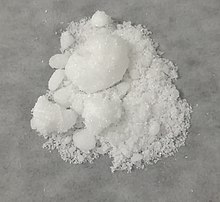Cadmium bromide
Appearance
 | |
 | |
| Names | |
|---|---|
| IUPAC name
Cadmium(II) bromide
| |
| Other names
Cadmium dibromide
| |
| Identifiers | |
| |
3D model (JSmol)
|
|
| ChemSpider | |
| ECHA InfoCard | 100.029.241 |
| EC Number |
|
PubChem CID
|
|
| RTECS number |
|
| UNII | |
CompTox Dashboard (EPA)
|
|
| |
| |
| Properties | |
| CdBr2 | |
| Molar mass | 272.22 g/mol |
| Appearance | white solid |
| Density | 5.192 g/cm3, solid |
| Melting point | 568 °C (1,054 °F; 841 K) |
| Boiling point | 844 °C (1,551 °F; 1,117 K) |
| 56.3 g/100 mL (0 °C) 98.8 g/100 mL (20 °C) 160 g/100 mL (100 °C) | |
| Solubility | soluble in alcohol, ether, acetone and liquid ammonia. |
| -87.3·10−6 cm3/mol | |
| Structure | |
| Rhombohedral, hr9, SpaceGroup = R-3m, No. 166 | |
| Hazards | |
| GHS labelling: | |
 
| |
| Warning | |
| H302, H312, H332, H410 | |
| P220, P273, P280, P501 | |
| NFPA 704 (fire diamond) | |
| Lethal dose or concentration (LD, LC): | |
LD50 (median dose)
|
225 mg/kg, oral (rat) |
| NIOSH (US health exposure limits): | |
PEL (Permissible)
|
[1910.1027] TWA 0.005 mg/m3 (as Cd)[1] |
REL (Recommended)
|
Ca[1] |
IDLH (Immediate danger)
|
Ca [9 mg/m3 (as Cd)][1] |
| Related compounds | |
Other anions
|
Cadmium chloride, Cadmium iodide |
Other cations
|
Zinc bromide, Calcium bromide, Magnesium bromide |
Except where otherwise noted, data are given for materials in their standard state (at 25 °C [77 °F], 100 kPa).
| |
Cadmium bromide is the inorganic compound with the formula CdBr2. It is a white hygroscopic solid. It also can be obtained as a mono- and tetrahydrate.[2] It has few applications.
Preparation and structure
[edit]Cadmium bromide is prepared by heating cadmium with bromine vapor.[2] The tetrahydrate has been obtained by crystallization of the dibromide from aqueous solution. At 3.04 g/cm3, it is much less dense than the anhydrous material. According to X-ray crystallography, the tetrahydrate is a polymer of CdBr2(H2O)2 with bridging bromide ligands. There are two interstitial water molecules[3]
References
[edit]- ^ a b c NIOSH Pocket Guide to Chemical Hazards. "#0087". National Institute for Occupational Safety and Health (NIOSH).
- ^ a b F. Wagenknecht; R. Juza (1963). "Cadmium bromide". In G. Brauer (ed.). Handbook of Preparative Inorganic Chemistry, 2nd Ed. Vol. 2. NY, NY: Academic Press. p. 1096.
- ^ Leligny, H.; Monier, J. C. (1978). "Structure Cristalline de CdBr2.4H2O". Acta Crystallographica Section B. 34 (1): 5–8. Bibcode:1978AcCrB..34....5L. doi:10.1107/S0567740878002186.

